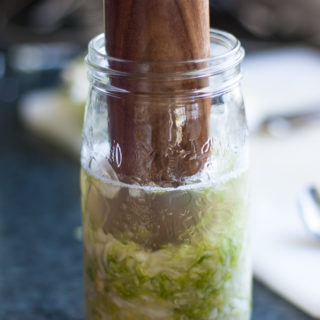Ingredients
- 1 large cabbage to yield about 2-3 lbs shredded
- 2 Tbsp sea salt
- 2 or so wide mouth mason jars to fit your volume of cabbage
Extra brine
- 1/2 C boiling water
- 1/2 tbsp sea salt
- Dissolve salt in water cool and use to top up if necessary
Instructions
-
Sterilize two large mason jars using the boiling water or oven method.
-
Core and slice cabbage into thin ribbons. You can use a chef's knife or a food processor. Place cabbage into a large bowl.
-
Sprinkle salt over cabbage and mix with hands to distribute evenly.
-
Leave to sit for about 10 minutes, then massage cabbage vigorously to begin to break down the fibres and release the natural juices. Do not discard the liquid!
-
Once the cabbage has softened and reduced in volume, spoon it into your jars in layers. It should almost look a bit like you've cooked it.
-
Pack the cabbage down tightly, pressing on each layer with a meat mallet, kraut pounder or the back of a spoon. You want to remove as much air as possible, while extracting the natural juices even further. Be aware of overflow from the displacement of the pounder - do this in a bowl so you can save the liquid and pour it over the top once the pounder has been removed and its volume displaced.
-
Fill to about 3/4" -1" from the top of the jar
-
Top the cabbage with a clean whole leaf to prevent the shreds from floating to the top, then place a clean rock, fermentation weight or a baggie full of water into the top of the jar, or fit it with an airlock lid. You want to keep the cabbage under the water at all times and may have to top the jar up with a little brine at some point during your fermentation.
-
Place the lid back on the jar. If not using an airlock device you may need to burp your jars every day for at least the first week to allow any gasses to release.
-
Leave at room temperature for several days or up to a month. Keep an eye on it and discard it if it becomes foul smelling. It may increase a little or quite a lot in volume at the beginning, so place it onto a few paper towels or a large plate to catch any liquid that rises up and over the jar. As it ferments you may find that the volume of liquid then goes down, top up with a bit of extra brine if needed to keep cabbage submerged.
-
Refrigerate when it is as tart as you like it. It is naturally preserved and will keep for months in the fridge.
Recipe Notes
Slight darkening of the cabbage at the top, or even a slight scum (as long as it doesn't smell bad) can simply be removed before consuming. It is a natural part of the process
